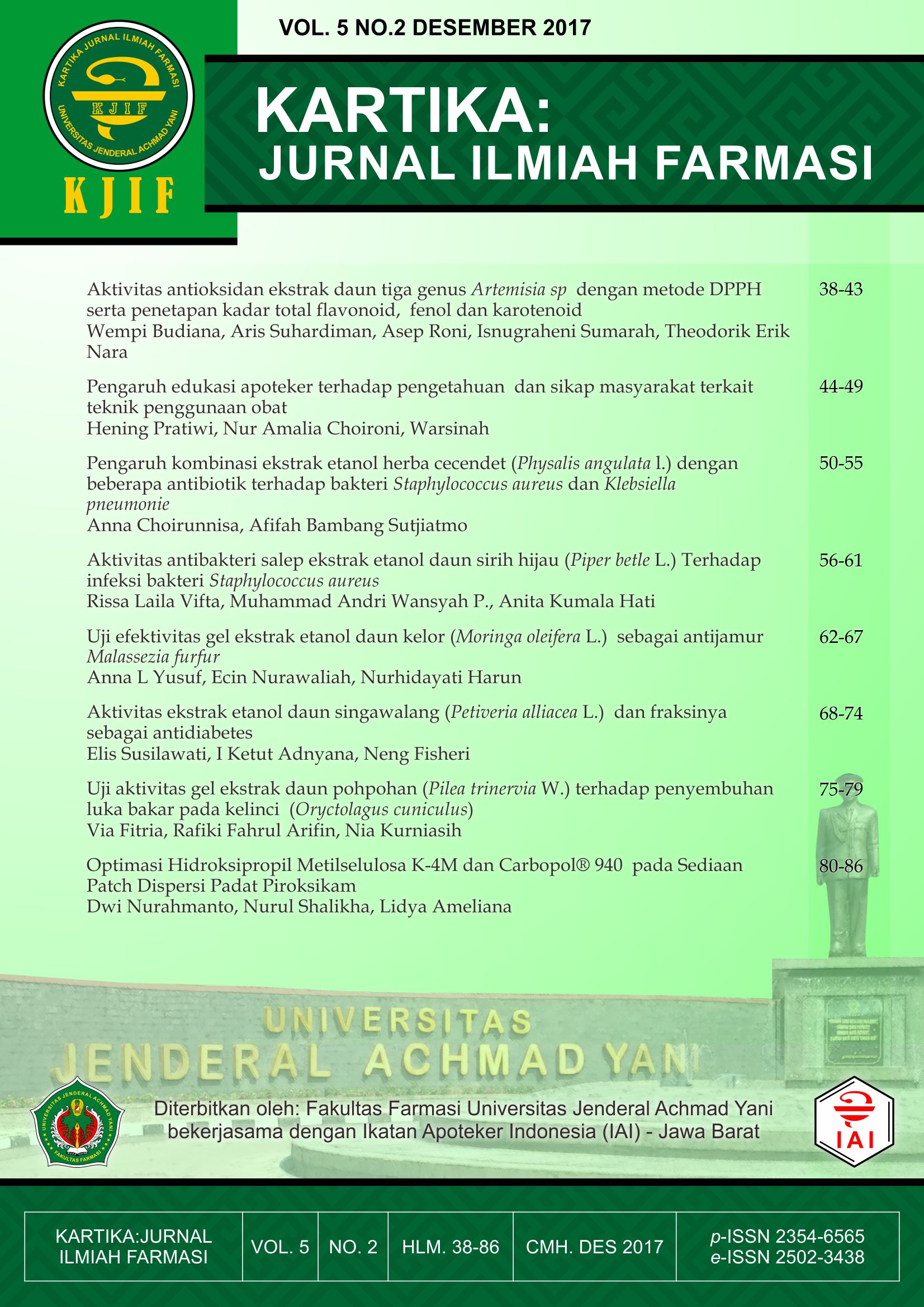Optimasi Hidroksipropil Metilselulosa K-4M dan Carbopol® 940 pada Sediaan Patch Dispersi Padat Piroksikam
DOI:
https://doi.org/10.26874/kjif.v5i2.121Abstrak
Abstrak
Â
Piroksikam merupakan anti inflamasi non steroid (AINS) turunan oksikam yang berkhasiat sebagai analgesik dan antiinflamasi digunakan untuk pengobatan rheumatoid arthritis dan osteoarthritis. Piroksikam menyebabkan masalah pada saluran cerna dan first pass metabolism yang dapat dihindari dengan cara pemberian transdermal patch. Salah satu komponen patch yaitu polimer yang berfungsi untuk mengontrol kecepatan pelepasan obat dari sediaan. Penelitian ini dilakukan untuk menentukan komposisi terbaik dari kombinasi polimer hidroksipropil metilselulosa (HPMC) dan Carbopol terhadap % moisture content (MC) dan flux pelepasan sediaan transdermal patch dispersi padat piroksikam dengan rancangan formula Simplex Lattice Design. Piroksikam dibuat dalam bentuk dispersi padat dengan pembawa PEG 4000 untuk meningkatkan kelarutannya. Rancangan formula patch dispersi padat piroksikam dibuat dengan menggunakan tiga polimer Etil selulosa:HPMC:carbopol dimana yang divariasikan adalah perbandingan HPMC : Carbopol yaitu 1 : 0 ; 0,5 : 0,5 ; 0 : 1. Hasil uji menunjukkan ketiga formula memenuhi persyaratan keseragaman kadar dengan rentang keseragaman 3,735 – 97,349 %. Hasil juga menunjukkan formula 3 menghasilkan patch yang lebih tebal, pH permukaan patch lebih rendah, nilai % moisture content lebih besar dan nilai flux lebih tinggi dibandingkan formula 2 dan formula 3, Formula 3 mempunyai nilai % moisture content yang memenuhi persyaratan sebesar 6,613% dan nilai flux pelepasa yang paling bagus sebesar 32,562 µg/cm2.menit1/2. Hasil penelitian juga menunjukkan formula 1 memiliki keseragaman bobot lebih baik dibandingkan formula 2 dan formula 3. Dapat disimpulkan bahwa komposisi optimum dari kombinasi polimer HPMC dan Carbopol pada sediaan patch dispersi padat piroksikam yaitu formula dengan komposisi polimer HPMC sebanyak 0 mg dan Carbopol sebanyak 75 mg.
Â
Kata kunci:Â Â Â Â Dispersi padat, patch piroksikam, HPMC, Carbopol
Â
Optimization of Hydroxypropyl Methylcellulose K-4M and Carbopol® 940 in Solid Dispersion Piroxicam Patch
Â
Abstract
Â
Piroxicam is a non-steroidal anti-inflammatory (NSA) oxysmic derivative as an analgesic and anti-inflammatory agent used for the treatment of rheumatoid arthritis and osteoarthritis. Piroxicam causes problems in the gastrointestinal tract and first pass metabolism that can be avoided by giving transdermal patches. One of the patch components is a polymer that serves to control the speed of drug release from the preparation. The present study was conducted to determine the best composition of the combination of hydroxypropyl methylcellulose (HPMC) and Carbopol polymers against% moisture content (MC) and fluxes release of the pyroxicam dispersion transdermal patch dispersion with the design of the Simplex Lattice Design formula. Piroxicam is prepared in the form of a solid dispersion with a PEG 4000 carrier to increase its solubility. The design of a pyroxicam solid dispersion patch formulation was prepared using three ethyl cellulose polymers: HPMC: carbopol wherein the HPMC ratio is computed: Carbopol is 1: 0; 0.5: 0.5; 0: 1. The test results show the three formulas meet the requirements of uniformity of the content with a uniformity range of 3.735 - 97.349%. the results also show formula 3 resulting in thicker patches, lower patch pH surfaces, greater moisture content values and higher flux values than formula 2 and formula 3, Formula 3 has a moisture content value of 6.613% the finest fl ux flux of 32,562 μg / cm2.menit1 / 2. The results also show that formula 1 has better weight uniformity than formula 2 and formula 3. It can be concluded that the optimum composition of HPMC and Carbopol polymer combinations in the preparation of piroxicam solid dispersion patch is a formula with HPMC polymer composition as 0 mg and Carbopol as much as 75 mg..
Â
Key words: Â Â Â Â solid dispersion, piroxicam patch, HPMC, Carbopol
Referensi
Bharkatiya, M., Bhatnagar, M. & Nema, R., 2010, Designing and characterization of drug free patches for transdermal, International Journal of Pharmaceutical Sciences and Drug Research, 2(1): 35-39.
Bhattacharyya, M., Basu, S. K., Gupta, B. K. & Ghosal, S. K., 1993, Formulation and in vitro - in vivo characterization of solid dispersions of piroxicam, Drug Development and Industrial Pharmacy,19(6): 739-747.
Chiou, W.L., & Riegelman S., 1971, Pharmaceutical application of solid dispersion system, Journal of Pharmaceutical Science, 60(9): 1281-130.
Depkes RI, 2014, Farmakope Indonesia Edisi V, Direktorat Jenderal Pengawas Obat dan Makanan Departemen Kesehatan Republik Indonesia, Jakarta.
Huber, L., 2007, Validation and qualification in analytical laboratories. 2nd ed, Informa USA, Inc, New York.
Jhawat, V.C., Saini V., Kamboj S., & Maggon N., 2013, Transdermal drug delivery system : approaches and advancements in drug absorvtion through skin. International Journal of Pharmaceutical Sciences Review and Research, 20(1): 47-56.
Kumar, S. V., Tarun, P. & Kumar, T. A., 2013, Transdermal drug delivery system for non-steroidal anti anflammatory drugs: a review, Indo American Journal of Pharmaceutical Research, 3(4): 3588-3605.
Pandit, V., Khanum A., Bhaskaran S., & Banu V., 2009, Formulation and evaluation of transdermal film for the treatment of psychosis, International Journal of Drug Delivery, 4: 470-476.
Panwar, A.S., Nagori, Chauhan J., Darwhekar G. N., & Jain D.K., 2011, Formulation and evaluation of fast dissolving tablet of piroxicam, American Journal of PharmTech Research, 1(3): 255-273.
Patel, D., Chaudhary S. A., Parmar B., & Bhura N., 2012, Transdermal drug delivery system: a review, The Pharmaceutical Innovation, 1(4).
Rowe, R. C., Sheskey P. J., & Quinn M. E., 2009, Handbook of Pharmaceutical Excipient 6th Edition, Pharmaceutical Press and American Pharmaceutical Association, UK.
Schiantarelli, P., Cadel, S., Arcebi, D. & Pavesi, L, 1982, Antiinflamatory activity and bioavailability of percutaneous piroxicam, Arzneim-Forsch, 32: 230-235.
Ubaidullah, U., Reddy M. V. S., Ruckmani K., Ahmad F. J., & Khar R. K., 2006, Transdermal therapeutic system of carvedilol: effect of hydrophilic and hydrophobic matrix on in vivo and in vitro characteristics, American Association of Pharmaceutical Scientists Pharm Sci Tech, 8(1). P: 1-8.
Walters, K. & Robert, M., 2001, Dermatological and transdermal formulation: the structure and function of skin, Marcel Dekker Inc, New York
##submission.downloads##
Diterbitkan
Cara Mengutip
Terbitan
Bagian
Lisensi
Penulis yang menerbitkan artikel pada jurnal ini menyetujui ketentuan berikut:
- Penulis memberikan hak cipta dan jaminan atas artikel sebagai publikasi pertama, yang memberikan kesempatan pada orang lain untuk membagi artikel dibawah lisensi Creative Commons Attribution License
- Penulis dapat melakukan perubahan dan menambahkan untuk pendistribusian artikel yang terpublikasi secara non eksklusif (misalnya, mempostingnya ke repositori institusional atau mempublikasikannya dalam sebuah buku), dengan pengakuan publikasi awal dalam jurnal ini.
- Penulis diizinkan dan didorong untuk memposting pekerjaan mereka secara online (misalnya, di repositori institusional atau di situs web mereka) sebelum dan selama proses pengajuan, karena dapat mengarah pada pertukaran produktif, serta kutipan pekerjaan sebelumnya dan lebih besar yang diterbitkan (Lihat The Effect of Open Access).























